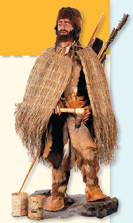22.3 Seed Plants
Understand Key Concepts
All of the following are characteristics of gymnosperms EXCEPT
vascular tissue.
seeds.
cones.
flowers.
The male reproductive structures of seed plants are called
sperm.
ovules.
pollen grains.
sporophytes.
The structures on a pine tree that contain the gametophytes are
flowers.
sporangia.
sori.
cones.
The green structure in the diagram is called
an embryo.
a seed coat.
a spore.
stored food.

What is the function of a seed coat?
How do gymnosperm seeds differ from angiosperm seeds?
What reproductive adaptations allow conifers to live in dry habitats?
Think Critically
Compare and Contrast Describe the primary similarities and differences between gymnosperms and angiosperms.
Infer During the age of the dinosaurs, the vast majority of land plants were ferns and mosses. Today, the vast majority are seed plants. Provide an explanation for this change based on the basic requirements of plants.
Apply Concepts Explain the structure and function of a seed cone and pollen cone. Explain their respective roles in reproduction.
solve the CHAPTER MYSTERY

STONE AGE STORYTELLERS
Iceman's story is continually evolving as additional evidence is analyzed. But so far, the plants found with him have revealed a lot. The abundance of chlorophyll in the maple leaves and the species of pollen in his digestive tract both point to a death in late spring. Distinct layers of pollen in his digestive tract suggest that Iceman changed his elevation quite dramatically several times on his final day.
The unfinished bow suggests that Iceman's journey into the mountains was unplanned. Perhaps he was fleeing an enemy? In fact, several years after the bow was found a CT scan of Iceman revealed a stone arrowhead lodged beneath his left shoulder blade and the large gash that the arrowhead left in a major artery.
And what of his society? The primitive wheat in his digestive tract and other intact grains found on his clothes suggest that Iceman's society practiced an early form of agriculture.
Apply Concepts A clump of moss was also found with Iceman's possessions. Some scientists hypothesize that Iceman used the moss like we use tissues or paper towels today. What property of moss would allow this function? Why is this adaptation necessary for mosses? Hint: What kind of tissue do they lack that other land plants have?
Communicate Write a letter to a friend summarizing the information provided by plant evidence found with Iceman.
Connect to the
 Pollen and seeds are the most reliable plant-related evidence at archeological sites and at modern-day crime scenes because they are long-lasting. Relate this quality to their structure and function in living plants.
Pollen and seeds are the most reliable plant-related evidence at archeological sites and at modern-day crime scenes because they are long-lasting. Relate this quality to their structure and function in living plants.

Table of Contents
- Formulas and Equations
- Applying Formulas and Equations
- Mean, Median, and Mode
- Estimation
- Using Measurements in Calculations
- Effects of Measurement Errors
- Accuracy
- Precision
- Comparing Accuracy and Precision
- Significant Figures
- Calculating With Significant Figures
- Scientific Notation
- Calculating With Scientific Notation
- Dimensional Analysis
- Applying Dimensional Analysis




